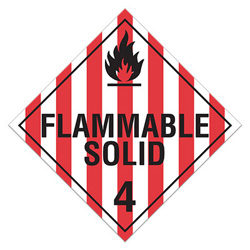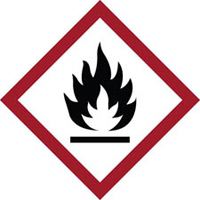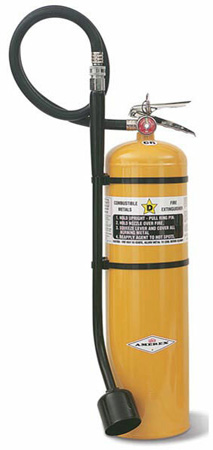



Find all of your laboratory and workplace safety supplies at Safety Emporium!
 Flammable Limits |
 Glossary Index |
 Flash point |
| MSDS Topics |
Free Sites | FAQ's | Regulations | Glossary | Software | Suppliers |
| Books | Forum | Poll | Fun stuff | Quiz | Store | |
| Understand your MSDS with the MS-Demystifier | Search ALL our MSDS info | |||||

Be sure you're in compliance with DOT placards and labels from Safety Emporium.
A flammable solid is defined by the U.S. Department of Transportation (DOT) quite extensively (see 49 CFR 173.124). Three broad classes are:
Paragraph B.7 of Appendix B of the 2012 version of the OSHA Hazard Communication Standard (HCS 2012), 29 CFR 1910.1200 defines a flammable solid as one that is "a readily combustible solid, or which may cause or contribute to fire through friction."
Paragraph B.7 of HCS 2012 outlines several principles for the hazard classification of a flammable solid and then assigns materials to one of two Categories using the following criteria:
| Category | Criteria |
| 1 | Burning rate test: Chemicals other than metal powders: (a) wetted zone does not stop fire; and (b) burning time < 45 s or burning rate > 2.2 mm/s Metal powders: burning time ≤ 5 min |
| 2 | Burning rate test: Chemicals other than metal powders: (a) wetted zone stops the fire for at least 4 min; and (b) burning time < 45 s or burning rate > 2.2 mm/s Metal powders: burning time > 5 min and ≤ 10 min |

Flame pictograms and other GHS-compliant labels and signs are available from Safety Emporium.
The labeling provisions of HCS 2012 require that Category 1 or 2 flammable solid containers carry the flame pictogram (shown on the right) to provide a quick visual warning of the flammability hazard. The GHS does not require these symbols to appear on the SDS itself, however most responsible manufacturers will do so to preserve the correspondence between a substance's SDS and label.
Because of the special hazards posed by flammable solids (and other dangerous goods), shipment of these materials can be difficult. For example, the US Postal Service will not accept shipments of flammable solids by air, and will only ship these by ground subject to certain restrictions. Likewise, United Parcel Service requires the shipper to be HazMat-certified and has limitations on quantities. All carriers, including FedEx, have special handling fees for such shipments.
DOT has very hefty fines for violation of dangerous goods shipping regulations. For example, in 2014, Amazon was fined $91,000 for shipping an improperly packaged and labeled one gallon container of flammable liquid that sprung a leak during transport. Later that year, they were assessed a $350,000 fine for a leaky package that injured several UPS workers.
The Safety Data Sheet for a flammable solid will note this hazard under Section 2 (Hazard(s) identifications) as well as several other sections regarding firefighting measures, storage, stability and reactivity, transportation, and more. Always ready the complete SDS in detail for such substances.
Always use caution around flammable (or potentially flammable solids). For example, most people do not normally think of aluminum metal as a flammable solid, but when finally divided into dust (or heated to high temperature) it can readily ignite with a fierce flame that can not be extinguished with a typical fire extinguisher. Uranium is another metal that some may not recognize as flammable.

Get your Class D and other specialty extinguishers from Safety Emporium.
If you are using flammable metals (lithium, sodium, potassium etc.) or flammable metal compounds (butyllithium, diethylzinc etc.) recognize that using water or carbon dioxide fire extinguishers can fuel fires of these sorts. You must have a class D extinguisher on hand if you are using these materials. See this reference for details.
Industrial flammable metal fires are some of the most terrifying incidents one can imagine. Some examples include:
See also: combustible, flammable, flash point, water reactive.
Additional definitions from Google and OneLook.
Entry last updated: Thursday, July 7, 2022. This page is copyright 2000-2025 by ILPI. Unauthorized duplication or posting on other web sites is expressly prohibited. Send suggestions, comments, and new entry desires (include the URL if applicable) to us by email.
Disclaimer: The information contained herein is believed to be true and accurate, however ILPI makes no guarantees concerning the veracity of any statement. Use of any information on this page is at the reader's own risk. ILPI strongly encourages the reader to consult the appropriate local, state and federal agencies concerning the matters discussed herein.